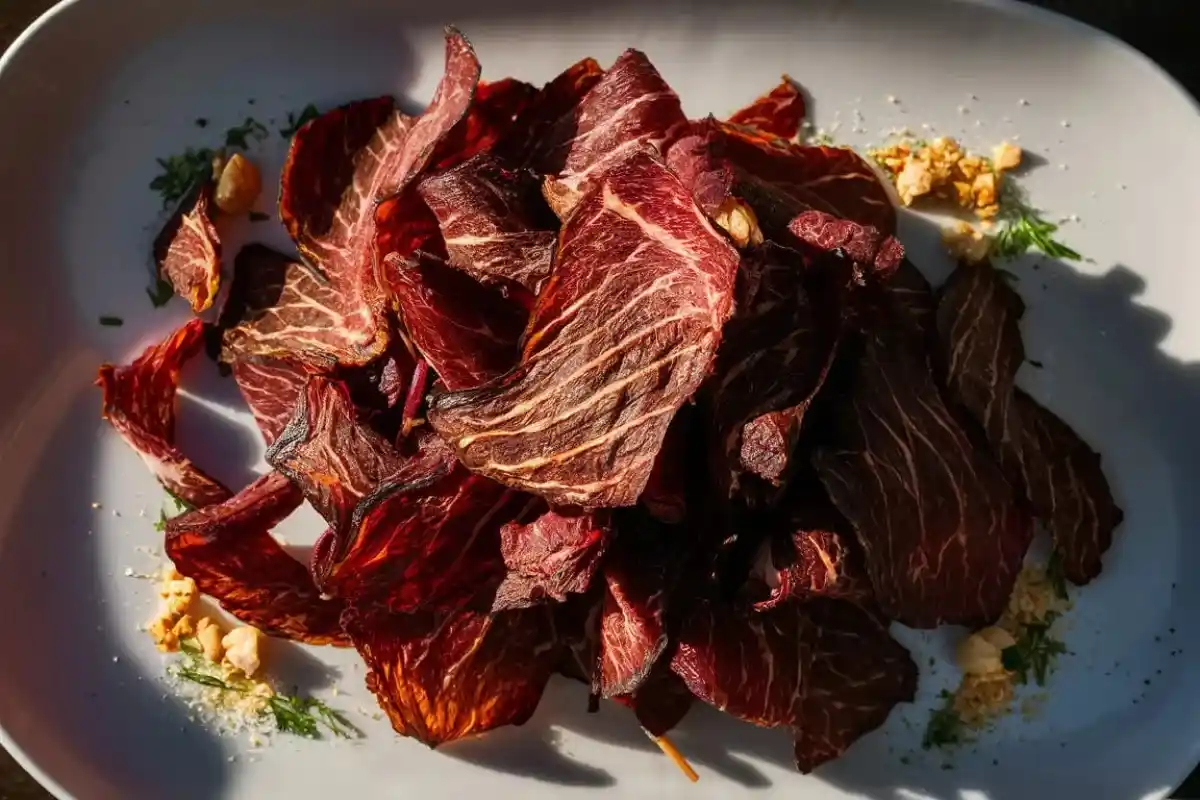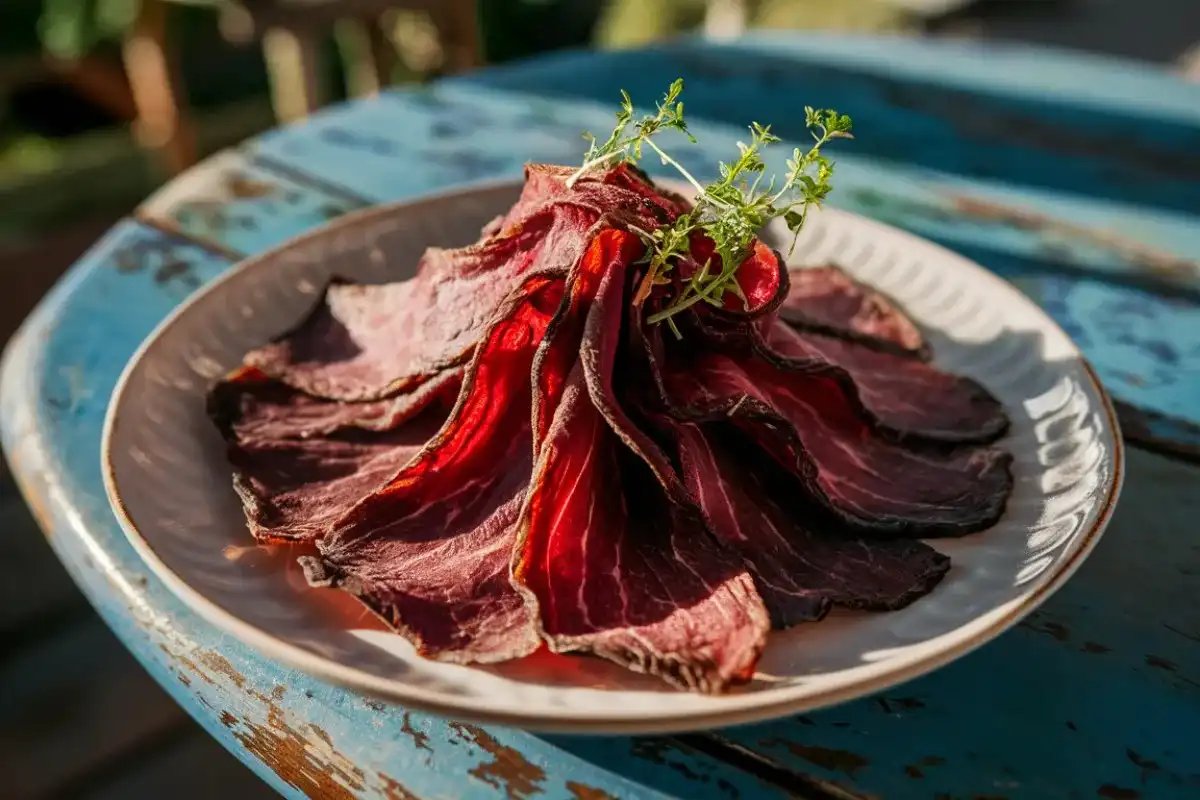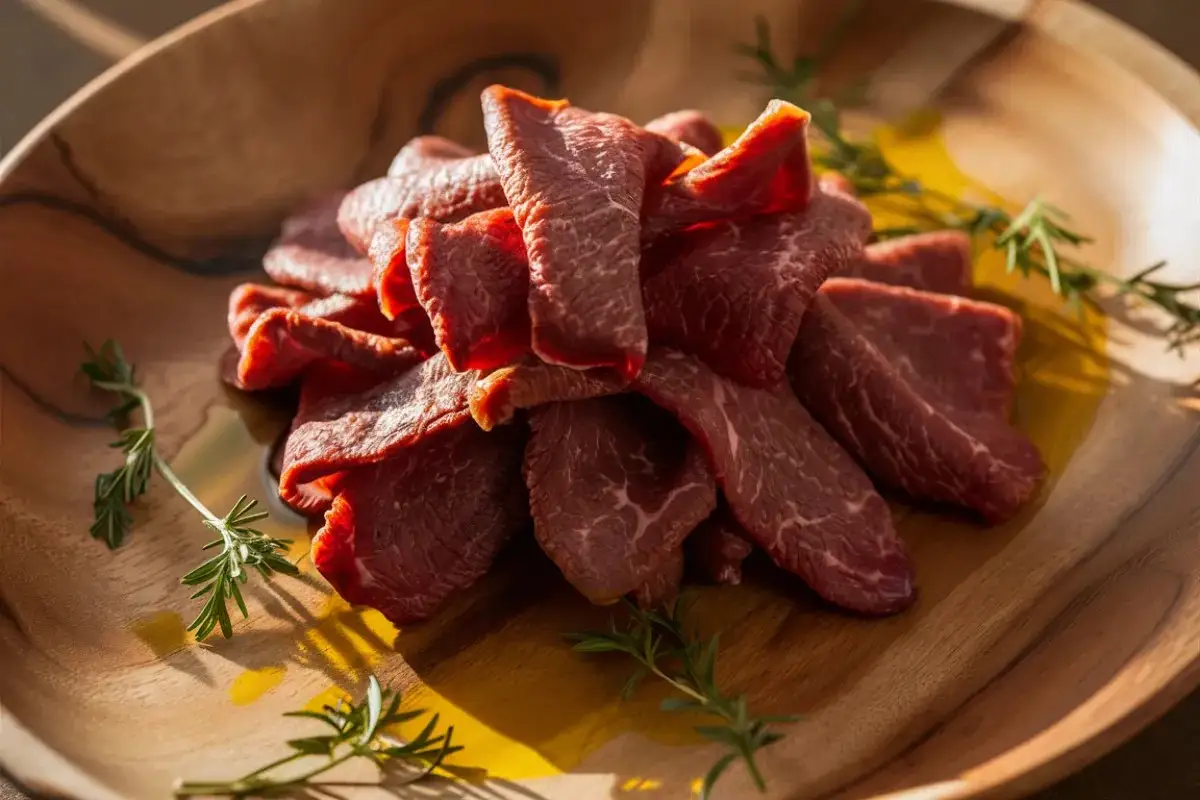Dried beef is a popular choice for many due to its extended shelf life, portability, and rich taste. It’s commonly used by hikers, campers, and anyone looking for a quick, protein-rich snack that does not require refrigeration. While dried beefs is known for its longevity compared to fresh meat, it can still spoil over time. Factors like storage conditions, ingredients, and packaging play a critical role in determining how long dried beefs will remain safe to eat.
How Dried Beef Is Made
Dried beef is created through various preservation methods that remove moisture from the meat, making it less hospitable for bacteria and mold. There are a few common techniques used to dry beef:
- Dehydration: A method that uses low heat over an extended period to remove water from the meat. The beef is often cut into thin slices and placed in a dehydrator or low-temperature oven until it loses most of its moisture.
- Freeze-Drying: Involves freezing the meat first, then reducing the surrounding pressure to allow the frozen water in the meat to sublimate directly from ice to vapor. This process preserves the meat’s structure and taste better than other methods.
- Curing: Uses salt, and sometimes sugar, to draw moisture out of the meat. This method often includes adding seasonings or spices to enhance the flavor while the salt acts as a preservative.
Each of these methods has its benefits, but they all share a common goal: to remove enough moisture from the meat to prevent bacterial growth, thereby extending its shelf life. Although these processes are effective, dried beefs is not immune to spoilage. For example, the shelf life of beefs jerky, one of the most common forms of dried beefs, can vary depending on storage conditions and preparation methods. You can learn more about different types of beef jerky in our article on Is Beef Jerky Just Dehydrated Meat?.
Factors Affecting the Shelf Life of Dried Beef

Understanding the various factors that affect the shelf life of dried beefs is crucial for keeping it fresh for as long as possible. Here are some of the primary factors to consider:
Storage Conditions
Storage conditions play a pivotal role in the longevity of dried beef. Ideally, it should be stored in a cool, dark place with low humidity. Moisture is the primary enemy of dried beefs, so keeping it in an environment free from dampness will help it last longer. For example:
- Cool and Dry Environments: Storing dried beefs in a pantry or cupboard that maintains a stable, cool temperature can prevent it from going bad too quickly. High temperatures can cause fat to spoil and lead to bacterial growth.
- Airtight Packaging: Using vacuum-sealed bags or airtight containers helps to keep air and moisture away from the beef, which is essential for extending its shelf life. Oxygen absorbers can also be added to the packaging to further protect the beef from moisture and mold.
For a more detailed guide on how to store beef jerky to maximize its shelf life, check out our article on How to Store Beef Jerky Long Term.
Ingredients and Quality of Beef
The type and quality of beef used for drying also play a significant role in how long it will last:
- Lean Cuts of Beef: Cuts with lower fat content are ideal for drying because fat tends to spoil faster than lean meat. Cuts like sirloin or round are commonly used because they have less fat.
- Additives and Seasonings: Some dried beef products contain preservatives like sodium nitrate or sodium nitrite, which help prevent spoilage and extend shelf life. Spices, herbs, and other natural ingredients may also have antimicrobial properties that can help prolong the beef’s freshness.
Packaging Types
Proper packaging is essential for maintaining the quality and safety of dried beef over time:
- Vacuum-Sealed Bags: These bags are effective in removing air, which prevents oxidation and slows down the degradation process. They are a preferred choice for both commercial and homemade dried beefs.
- Airtight Containers: Plastic or glass containers with tight-fitting lids are also suitable for storing dried beefs, especially when combined with oxygen absorbers or silica gel packs.
- Mylar Bags with Oxygen Absorbers: These bags are highly effective for long-term storage as they block out light, air, and moisture, all of which can cause dried beefs to spoil.
Moisture Content
Moisture content is a critical factor in determining how long dried beef will remain edible:
- Low Water Activity: The lower the water activity level, the less likely it is for bacteria to grow. Beef that has been properly dried will have a low moisture content, making it less susceptible to mold and bacterial growth.
- Avoiding Rehydration: It’s important to avoid storing dried beef in places where it could come into contact with water or high humidity levels, as this can rehydrate the meat and make it prone to spoilage.
How Long Does Dried Beef Last?

The shelf life of dried beef varies depending on its preparation method, packaging, and storage conditions:
Commercially Produced vs. Homemade Dried Beef
- Commercially Produced Dried Beef: Typically has a longer shelf life due to professional packaging, the use of preservatives, and controlled drying processes. It can last anywhere from 1–2 years if unopened and stored correctly.
- Homemade Dried Beef: Usually has a shorter shelf life unless it is vacuum-sealed and stored properly. If stored at room temperature, it might last a few weeks to a few months, depending on the conditions.
Different Types of Dried Beef
- Beef Jerky: Can last up to 2 years if unopened and stored in a cool, dry place. Once opened, it should be consumed within a month if stored at room temperature or up to six months if kept in the refrigerator.
- Freeze-Dried Beef: Known for its long shelf life, freeze-dried beefs can last 25–30 years if stored properly in airtight, moisture-proof containers.
- Dehydrated Beef: Has a shorter shelf life compared to freeze-dried beefs, usually lasting 1–2 months without refrigeration if stored correctly.
Storage Environment
- Pantry: Unopened beef jerky or dried beefs stored in a cool, dry pantry can last from a few months up to a year. Once opened, it should be consumed within a few weeks.
- Refrigerator: Opened dried beefs can last up to 6 months in the refrigerator, especially if stored in an airtight container or vacuum-sealed bag.
- Freezer: Storing dried beefs in the freezer can extend its shelf life up to 1 year or more. Freezing does not affect the safety of the beef but may alter its texture slightly.
For more specifics on the shelf life of different types of dried beefs, check our article How Long Does Beef Jerky Last?
Signs That Dried Beef Has Gone Bad
To ensure your dried beef remains safe to eat, be vigilant for signs of spoilage:
- Visual Indicators: Mold or discoloration on the surface of the beef is a clear sign that it has gone bad. The beef may also develop a slimy or sticky texture. You can learn more about identifying mold in foods from this guide on mold in foods.
- Smell: A sour, rancid, or off smell is a strong indicator that the dried beef is no longer safe to eat.
- Taste: If the beef tastes unusually bitter or has a strange flavor, it is best to discard it immediately.
Best Practices for Storing Dried Beef
To maximize the shelf life of dried beef, consider the following best practices:
Choosing the Right Storage Location
- Cool, Dark, and Dry Spaces: Store dried beef in a pantry or cupboard that maintains a stable, cool temperature with low humidity. Avoid storing it near heat sources or in direct sunlight, which can accelerate spoilage.
- Avoiding High-Humidity Areas: Areas like basements or bathrooms, where humidity levels fluctuate, are not ideal for storing dried beef.
Proper Packaging
- Vacuum-Sealed Bags: Using vacuum-sealed bags helps remove all air from the package, which significantly reduces the risk of spoilage by oxidation or moisture.
- Mylar Bags with Oxygen Absorbers: These bags provide an additional layer of protection against light and air. Adding oxygen absorbers inside the packaging can further enhance its longevity.
- Airtight Containers: Use plastic or glass containers with tight-fitting lids. Make sure the containers are thoroughly dry before adding the beef to prevent moisture from getting in.
Avoiding Common Storage Mistakes
- Do Not Use Open Containers: Open containers allow air and moisture to enter, which can lead to spoilage. Always use sealed or airtight containers.
- Keep Away from Strong Odors: Dried beef can absorb strong smells from the environment, which can affect its taste. Store it away from pungent substances like onions, garlic, or spices.
How to Tell if Dried Beef Has Gone Bad

Here are some reliable methods to determine if your dried beef is still safe to consume:
Visual and Sensory Checks
- Look for Mold or Discoloration: Inspect the beef carefully for any signs of mold, which may appear as fuzzy spots in white, green, or black. Discoloration, such as dark or faded patches, can also indicate spoilage.
- Texture Changes: Fresh dried beef should be dry and firm. If it feels slimy, sticky, or unusually soft, it may be starting to spoil.
Smell and Taste Tests
- Smell Test: Fresh dried beef has a distinct, beefy aroma. If you notice a sour or rancid odor, it’s best to discard the product.
- Taste Test: If the dried beef tastes off or unusually bitter, it may have gone bad. Always taste a small piece before consuming more.
Can You Extend the Shelf Life of Dried Beef?
Yes, you can take several measures to extend the shelf life of dried beef:
Re-Drying Techniques
If the dried beef starts to feel slightly moist, you can dehydrate it again using a food dehydrator or an oven set at a low temperature. This process will help remove any excess moisture that might have accumulated.
Freezing
Freezing dried beef is another effective method for extending its shelf life. Although freezing may slightly alter the texture, it will keep the beef safe to eat for a longer period. Make sure to store it in a freezer-safe, airtight container to avoid freezer burn.
Use of Preservatives
Adding natural preservatives like sodium nitrate or nitrite can help inhibit bacterial growth and prevent spoilage. Spices like garlic, pepper, and oregano have natural antimicrobial properties that can also help extend the shelf life of dried beefs.
Frequently Asked Questions
1. Can dried beef go bad if left unopened?
Yes, even unopened dried beefs can spoil if stored improperly or beyond its expiration date. Store it in a cool, dry place to maximize its shelf life.
2. What is the best way to store dried beef for the longest shelf life?
Store in vacuum-sealed containers or Mylar bags with oxygen absorbers in a cool, dry place. This will protect it from moisture, light, and air.
3. Is it safe to eat dried beef past its expiration date?
It depends on the storage conditions and whether there are any signs of spoilage. If it shows no signs of mold, discoloration, or off-smells, it may still be safe to eat. However, always use caution.
4. Why does my dried beef have a white film on it?
A white film could be salt crystallization, which is harmless. However, if the film has a different texture or color, it might be mold, and the beef should be discarded.
5. Can you make dried beef last longer by refrigerating or freezing it?
Yes, refrigeration or freezing can significantly extend the shelf life of dried beefs, especially once the package is opened.
Conclusion
Dried beef is a practical and long-lasting food option, but like all foods, it can go bad if not stored correctly. To keep your dried beef safe and delicious for as long as possible, store it in airtight packaging, in a cool, dry place, away from direct light and moisture. Regularly check for signs of spoilage, such as mold, off-smells, or discoloration, before consuming. With the right care and storage techniques, your dried beefs can remain edible for months or even years, depending on the type and storage method used.
For more information on storing beef products safely, explore our articles on beef jerky shelf life and ways to prevent beef jerky from molding. By understanding these factors, you can make the most out of your dried beefs and enjoy it at its best quality for a longer period.

